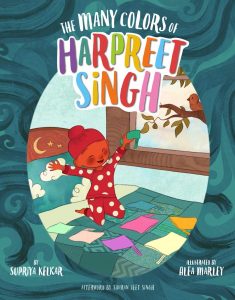 The Many Colors of Harpreet Singh
The Many Colors of Harpreet Singh
Written by Supriya Kelkar
Illustrated by Alea Marley
Sterling, 2019, 32 pp (unpaged)
ISBN: 978-1454931843
Harpreet Singh is an Indian American Sikh who has a different color patka (head covering) for every occasion. Harpreet’s patkas are part of his Sikh practices, but are also a way for him to express himself and his emotions. He wears yellow when he feels sunny and full of cheer, pink when he feels like celebrating, and red when he needs to feel brave. When his mom gets a job in a small snowy town across the country, Harpreet begins to wear colors for not-so-happy occasions because he is apprehensive about the move, regardless of his parents’ assurance that this is going to be a fun adventure. Harpreet wears blue and gray because he is nervous and sad. But most of all Harpreet wears white, as he feels shy and thinks it would be best to match the snowy cold outdoors to be invisible. His parents try to get him to wear different colors but he refuses. Then one day, Harpreet sees his classmate’s yellow hat in the snow. When he returns it to her, she says she loves his patka and he is reminded of how much he loves to be cheerful through colors. So, Harpreet starts to wear colors again to express his feelings, especially about his new friend.
Kelkar’s storytelling of Harpreet’s experience is clean and simple, beautifully depicting the power of color in Harpreet’s life as he changes patkas to reflect his feelings. Patkas are worn by young Sikhs to hide their long hair and keep it tidy. Kelkar does an excellent job of normalizing the religious practice of wearing head coverings by making it an expression of Harpreet’s personality. Readers are often faced with challenges when it comes to religious expression, since it is an avenue that involves individual belief systems and personal opinions. Tapping into elements that are specific to a particular person often gets sensitive because they go deeper than the surface–dealing with one’s heart and heavier internal battles.
This story focuses on the nervousness and loneliness of moving and finding your way in a new place. Kelkar’s emphasis on the emotion of colors becomes more powerful because the discovery of a new friend points to the sense of belonging Harpreet is searching for. The connection between social-emotional health and colors is important for readers to understand because it helps to make readers aware in a concrete way about the challenges of learning in a new place. A new place is a difficult adaptation for children, especially when cultural differences play a big factor in creating a comfortable, safe, accepting environment. Marley’s vibrant illustrations ingeniously convey the cultural differences that make Harpreet feel unaccepted and invisible to his classmates. For example, on the lunchroom page with his classmates, Harpreet has a traditional Indian meal of bread and soup, whereas his peers are depicted eating more American-style dishes like cake and fruit.
Moving for students can be challenging especially when they are entering a new environment that creates communication issues due to language. In My Two Blankets by Irena Kobald and Freya Blackwood (2015), becoming comfortable in a new language is personified by adding new patterns to a favorite quilt. While My Two Blankets focuses more on pattern than color, another book pair, The Color of Home, written by Mary Hoffman and illustrated by Karin Littlewood (2002), is the story of a boy in London who longs for the vibrant colors of Somalia, his homeland. When given a box of crayons, he draws a picture that helps him feel at home in a new place and also conveys the trauma of war. The Color Monster by Anna Llenas (2018) would be another great book pair as it taps into the idea of colors representing the social-emotional well-being of an individual.
Supria Kelkar was born and raised in the Midwest where she learned Hindi as a child through watching three Hindi movies a week. In addition to being an award-winning author she also is a screenwriter who has worked on the writing teams for several Hindi films.
Alea Marley is a children’s illustrator living and working in England. She has a passion for creating scenes filled with plant life, patterns, textures, whimsical movements and lots of color. In addition to those passions, Marley also loves being a part of books that are diverse because she believes every child deserves to see someone like themselves depicted in books.
Kate Jung, Trinity International University
© 2023 by Kate Jung

